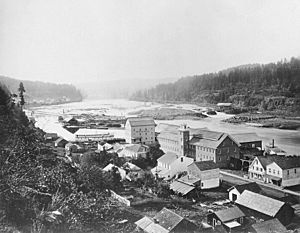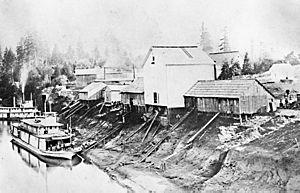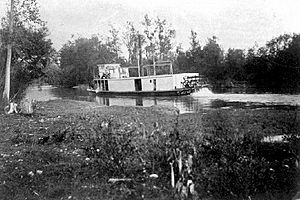James D. Miller facts for kids
Quick facts for kids
Captain James D. Miller
|
|
|---|---|
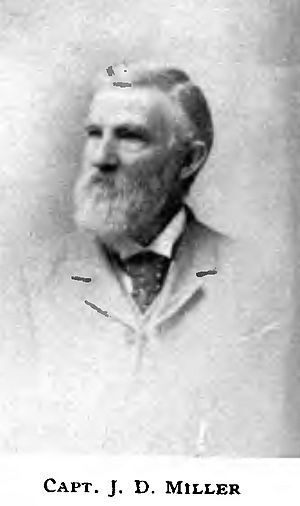 |
|
| Born | February 13, 1830 |
| Died | July 24, 1914 Spokane, Washington, US
|
| Occupation | Steamboat captain |
| Children | James D. Miller, possibly others |
Captain James D. Miller was a famous steamboat captain in the Pacific Northwest. He worked on rivers for over 50 years, from 1851 to 1903. He was known for commanding many different boats in many different places.
Contents
Early Life and Moving West
James D. Miller arrived on the Pacific Coast in 1848. When he reached Oregon, he traded his horses and mules for an acre of land. This land was just north of Oregon City, Oregon, in a place called Clackamas City.
Flatboat Adventures
In the spring of 1850, Miller started a business using a flatboat. This boat traveled between Canemah (above Willamette Falls on the Willamette River) and Dayton on the Yamhill River.
Miller built a flatboat that was 65 feet long. It could carry 350 bushels of wheat. He hired four members of the Klickitat First Nation as his crew. They used poles and oars to move the boat up the Yamhill River to Dayton and Lafayette. It took two days to go upstream and one day to return.
Miller charged $35 per ton to carry goods to farmers upstream. He also charged 50 cents per bushel to bring wheat back downriver. His main cost was paying his crew, which was $16 per man for each trip.
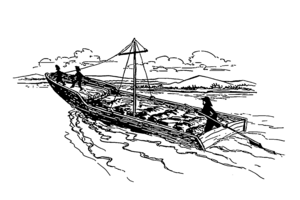
Starting a Steamboat Career
Miller had been in the flatboat business for about a year. Then, on May 19, 1851, the first steamboat appeared on the upper Willamette River. This was a small sidewheeler called the Hoosier. Even though it was small, the Hoosier could carry much more cargo than any flatboat.
Miller's flatboat business soon ended. However, he was hired by the Hoosier's owner, John Zumwalt. On board the Hoosier, Miller did many jobs. He was the bookkeeper, purser, pilot, deckhand, and roustabout.
In the fall of 1856, Miller and his brother-in-law, Silas R. Smith, bought the Hoosier. The next year, they built another steamboat called Hoosier No. 2. They ran this boat on the Willamette River between Champoeg and Butteville, and up the Yamhill River. Later, they rebuilt Hoosier No. 2 and named her Hoosier No. 3.
In 1858, Miller sold part of his share in Hoosier No. 3. He and his partners then bought the sternwheeler James Clinton. They operated her until April 23, 1861. On that day, the Clinton was destroyed by a fire at the dock in Linn City, Oregon. In 1860, Miller took the engine from the Hoosier and put it into a steam scow called Yamhill.
New Boats and a Flood
Soon after, Miller sold his share in the Yamhill to Captain John T. Apperson. Miller then went to the Snake River mines with Captain George A. Pease.
Meanwhile, Apperson had built a sternwheeler called Unio. Its unusual name came from Captain Apperson's uncertainty about the American Civil War, which had just started. He also had many customers who supported the South. When Miller returned in December 1861, he bought the Unio from Captain Apperson. Miller quickly added the letter "n" to the name, making it Union. He didn't care what his Southern-leaning customers thought!
Around this time, Miller's home was destroyed. A huge flood of the Willamette River hit on December 1, 1861. Most of Linn City was washed away. Miller's home was thought to be very safe, and other people took shelter there. But as the water rose, they had to leave just before the building was swept away.
Steamboat Pilot on the Willamette River
Except for a short time in 1862, Miller ran the Union on the Willamette River. In 1866, the People's Transportation Company bought the Union. After that, Miller became a pilot on the Fanny Patton with Captain George Jerome.
Next, Miller moved to the Enterprise (built in 1863) with Captain Sebastian "Bas" Miller. He stayed with the Enterprise until it was taken apart.
In 1868, Miller piloted the new steamer Albany with Captain Lon Vickers. After a short time on the Albany, Miller started a milling business in Oregon City. Soon after, he worked on the People's Transportation Company's steamers Onward, Senator, and E.N. Cooke.
Miller was a passenger on the Senator when it exploded in 1875 near the Alder Street dock in Portland, Oregon. The very next day, Miller took command of the E. N. Cooke. He ran her until the Oregon Steam Navigation Company bought the People's Transportation Company.
Financial Challenges
In 1878, Miller bought C. P. Church's share in some flour mills. He also bought the steamer A.A. McCully. Miller took the special geared machinery from the A.A. McCully and put it into another steamer called Success. Miller ran the Success up the Willamette River to Eugene, Oregon.
In 1879, Miller faced some money problems. He lost his mill business and the Success. He gave the Success to Z.J. Hatch. Miller then took command of the City of Salem. He ran her until 1881 for William Reid, carrying railroad materials to Ray's Landing and Dayton, Oregon.
Working in Idaho and Eastern Washington
For health reasons, Miller left his command of the City of Salem. He and others bought flour mills in Walla Walla, Washington Territory. From there, Miller went to Sand Point, Idaho. He ran the Henry Villard on Lake Pend Oreille. After the Henry Villard, he worked on the Katie Hallett, which ran on the Clarks Fork Yellowstone River.
Return to the Willamette Valley
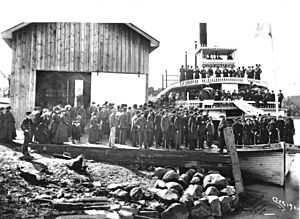
In the spring of 1882, Miller returned to Walla Walla. He sold his mill and went to Dayton, Oregon. In 1886, he retired to a farm. But he returned to the river in 1889. He again ran the City of Salem, this time between Fulquartz and Ray's landings until 1890.
Building a New Steamboat
Miller then went to Huntington, Oregon. He oversaw the building of the sternwheeler Norma. He made the first trip with her into the Seven Devils' Country. This was a 60-mile trip downriver into Hells Canyon to Seven Devils Landing, and then back upriver to Huntington.
Returning to Portland, he worked on several other steamers. These included the Governor Newell, Three Sisters, Toledo, and Joseph Kellogg during 1891-1892.
Adventures in the Kootenay Region
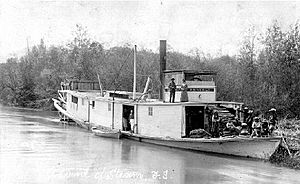
In 1893, Miller went to Montana. He took command of the steamer Annerly. She ran on the upper Kootenay River between Jennings, Montana and Fort Steele, BC. He stayed there until August 1894.
Then, he went to Puget Sound and bought the steamer Halys. He had her shipped inland to be used on the lower Kootenai River, operating out of Bonner's Ferry, Idaho. Miller commanded steamboats in the Kootenay region until 1901.
The Loss of the Gwendoline
In October 1898, the British Columbia Southern Railway was completed. This meant that three major steamboats on the upper Kootenay River were no longer needed. Miller had commanded all of them at different times: the J.D. Farrell, North Star, and Gwendoline.
Miller had an idea to move the Gwendoline by train to the Lardeau River and Kootenay Lake. He thought she could make money there. (The Kootenay River, which eventually flowed into Kootenay Lake, could not be traveled by boat below Jennings because of Kootenay Falls.)
Miller paid $500 for shipping fees. He arranged to have the Gwendoline loaded onto three flat cars. The train tracks ran along the side of a canyon. At one point, it looked like there wasn't enough room for the steamer to pass. The train crew moved the steamer away from the cliff face and a bit closer to the canyon edge. Sadly, the steamer was moved too far. It tipped off the flat cars and tumbled down into the canyon, landing upside down. It was completely destroyed.
Later Years and Legacy
From 1902 to 1903, Miller commanded steamboats on the Columbia River above Wenatchee, Washington.
Captain Miller passed away in Spokane, Washington, on July 24, 1914.
He likely had one of the longest careers in the steamboat business in the Pacific Northwest. During his time, Miller commanded 36 different steamboats! He worked on the Tualatin, Willamette, Columbia, and Kootenay rivers. Some of the boats he commanded included the Elwood, Multnomah, Undine, and Chelan. Captain Miller's son, also named James D. Miller, became a steamboat pilot too.


